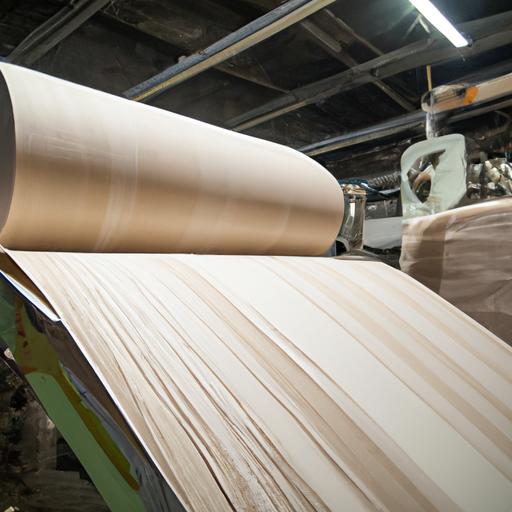Table of Contents
Paper is an everyday item that we often take for granted, but have you ever wondered how it’s made? Paper-making is a complex process that involves several steps, from the raw materials to the finished product. In this article, we’ll take a closer look at how paper is made and the impact it has on the environment.
Raw Materials

The first step in paper-making is selecting the raw materials. There are several types of fiber used in paper-making, including wood pulp, recycled paper, and cotton. Wood pulp is the most commonly used fiber and is obtained from trees. Recycled paper is made from waste paper that has been collected and processed for reuse. Cotton fibers are used for high-quality paper products, such as currency and fine stationery.
Once the raw materials have been selected, they are prepared for paper-making. Wood pulp is first debarked and chipped into small pieces. The chips are then chemically or mechanically separated into fibers. Recycled paper is sorted, cleaned, and processed into pulp. Cotton fibers are harvested from the cotton plant and then processed into pulp.
The pulp is then washed and bleached to remove impurities and create a uniform color. The resulting pulp is then ready for the paper-making process.
Pulping
The next step in paper-making is pulping. Pulping is the process of separating the fibers from other materials, such as lignin and hemicellulose. There are two main methods of pulping: chemical and mechanical.
Chemical pulping involves using chemicals to break down the lignin and hemicellulose in the fibers. This results in a high-quality pulp that produces strong and durable paper. However, chemical pulping is also more expensive and has a higher environmental impact.
Mechanical pulping involves mechanically grinding the pulp to separate the fibers. This results in a lower-quality pulp that produces weaker and less durable paper. However, mechanical pulping is also less expensive and has a lower environmental impact.
Once the pulp has been pulped, it is screened and cleaned to remove any remaining impurities. The resulting pulp is then ready for the paper-making process.
Pulping
After the raw materials have been prepared, the next step in paper-making is pulping. Pulping is the process of separating the fibers from other materials, such as lignin and hemicellulose. There are two main methods of pulping: chemical and mechanical.
Chemical pulping involves using chemicals such as sodium hydroxide and sodium sulfide to break down the lignin and hemicellulose in the fibers. This process is also known as the Kraft process, and it is the most commonly used method for producing pulp. The Kraft process produces a high-quality pulp that is strong and durable, making it suitable for a wide range of paper products.
Mechanical pulping involves mechanically grinding the pulp to separate the fibers. This process is less expensive than chemical pulping, but it also produces a lower-quality pulp that is weaker and less durable. Mechanical pulping is often used for newsprint and other low-cost paper products.
Once the pulp has been pulped, it is screened and cleaned to remove any remaining impurities. The resulting pulp is then ready for the paper-making process.
Papermaking
The next step in paper-making is papermaking itself. There are four main steps in the paper-making process: forming, pressing, drying, and finishing.
Forming is the process of creating a continuous sheet of paper from the pulp. The pulp is poured onto a moving mesh screen, and the water is drained away, leaving behind a mat of fibers. The mat is then pressed to remove any remaining water and to bond the fibers together.
Pressing is the process of further removing water from the mat of fibers. The mat is passed through a series of rollers that squeeze out the remaining water and create a uniform thickness.
Drying is the process of removing the remaining water from the paper. The paper is passed through a series of heated rollers that evaporate the water and dry the paper. Once the paper is fully dried, it is ready for finishing.
Finishing is the final step in the paper-making process. The paper is trimmed to the desired size, and any coatings or finishes are applied. The finished paper is then packaged and shipped to customers.
Additives and Finishing
Once the pulp has been processed and refined, additives are often added to improve the quality of the paper. Fillers such as clay and talc are added to increase the paper’s brightness and opacity, while dyes and coatings are used to enhance its appearance. Additives such as sizing agents are used to make the paper more resistant to water and ink penetration.
After the paper has been formed, it goes through a series of finishing processes. These processes include cutting, trimming, and packaging. The paper is cut into the desired sizes and shapes, trimmed to remove any excess material, and then packaged for distribution. The finishing processes ensure that the paper is of the highest quality and ready for use.
Environmental Impact
The paper industry has a significant impact on the environment, from the harvesting of raw materials to the disposal of waste products. The use of wood pulp for paper-making contributes to deforestation, habitat loss, and soil erosion. The chemicals used in the pulping process can also have harmful effects on the environment and human health.
To mitigate the environmental impact of paper production, the industry has implemented sustainable practices. These practices include using recycled paper, sourcing wood pulp from sustainably managed forests, and reducing water and energy consumption. The paper industry also invests in research and development to find new and innovative ways to reduce its environmental impact.
As consumers, we can also do our part to reduce the environmental impact of paper production. We can use recycled paper products, reduce our paper consumption, and properly dispose of paper waste through recycling programs. By working together, we can ensure that paper production is sustainable and has a minimal impact on the environment.